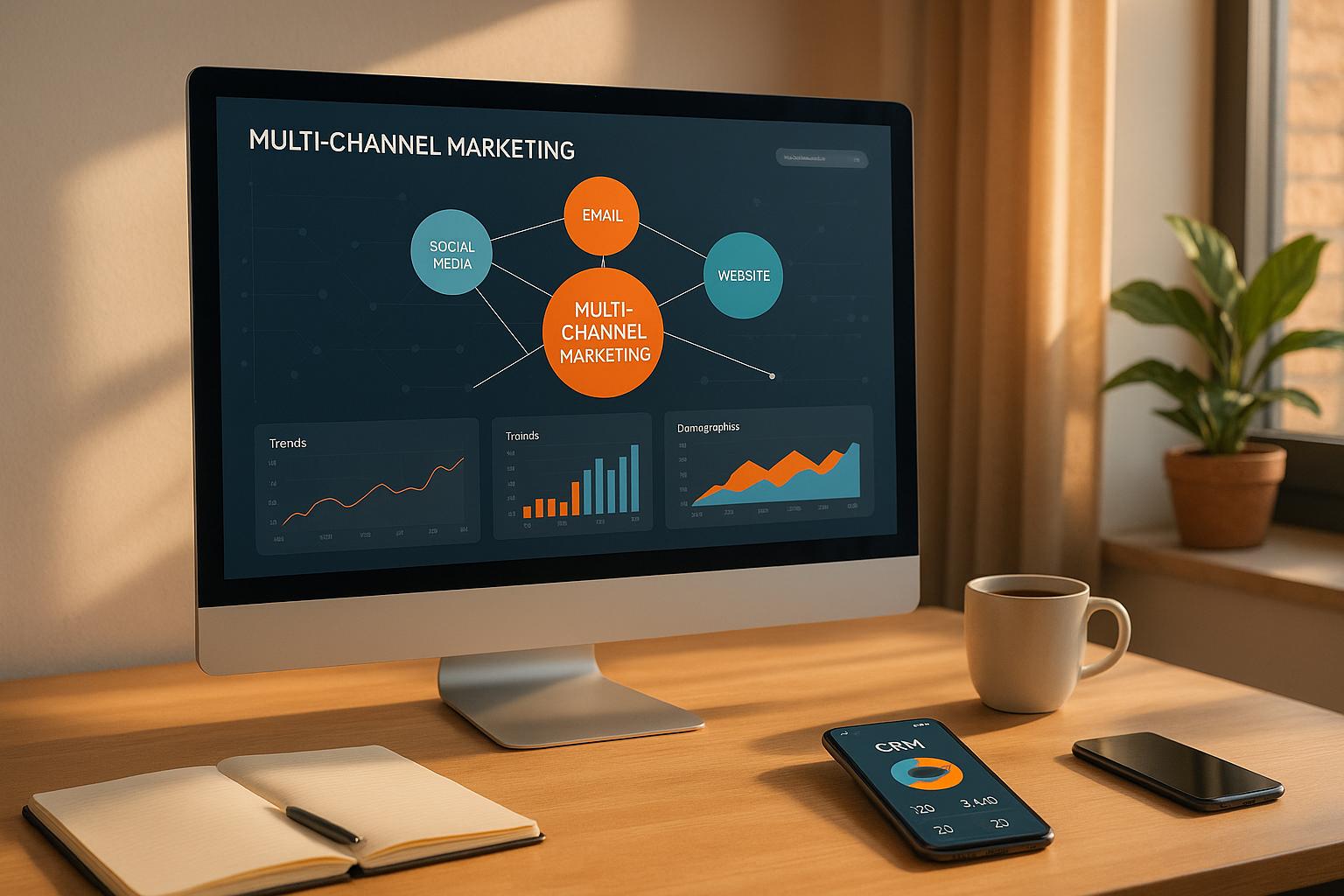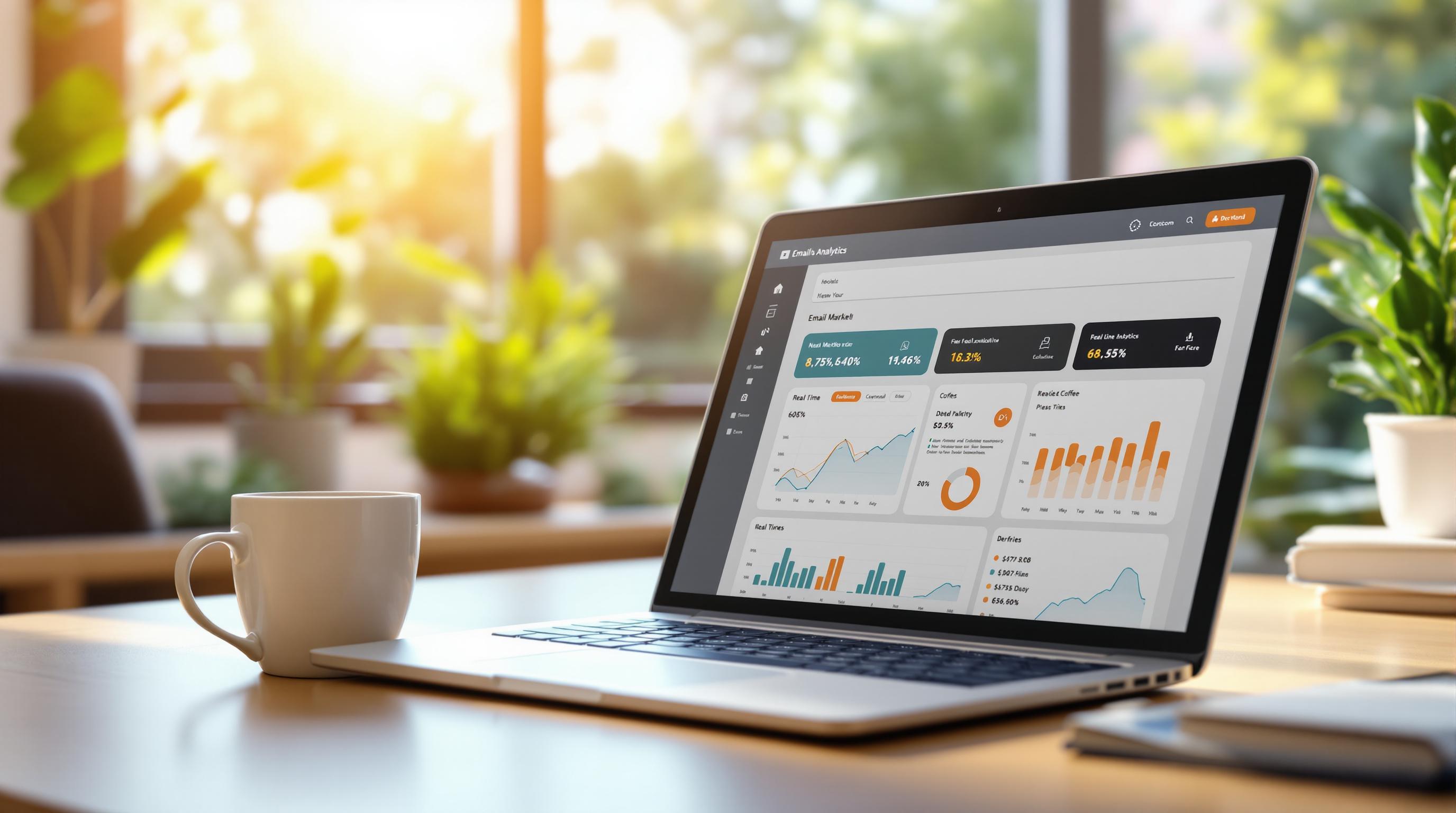A/B testing mobile emails is all about refining your strategy to match how people interact with emails on their phones. Mobile users scan quickly, tap instead of clicking, and often switch devices throughout the day. Here’s what you need to know to make your tests effective:
- Separate mobile and desktop tests: Combining them can lead to misleading results since user behavior differs significantly between devices.
- Focus on mobile-specific metrics: Track tap-to-open rates, scroll depth, and cross-device conversions for better insights.
- Test one element at a time: Whether it’s subject lines, CTAs, or layouts, isolating variables ensures accurate results.
- Design for mobile: Use single-column layouts, bold CTA buttons, short subject lines, and readable fonts.
- Find the right send times: Experiment with different times and days to see when your audience is most engaged.
- Use the right tools: Tools with device-specific analytics, real-time testing, and heat mapping can improve your campaigns.
How to A/B Test Emails | Ecommerce Examples | Best Practices
Common Problems in Mobile Email A/B Testing
Running A/B tests for mobile emails comes with its own set of hurdles that can skew your results. Understanding these challenges is essential if you want to ensure your testing data is accurate and actionable. Many of these issues directly affect the metrics we’ve already discussed.
Privacy Settings and Tracking Limits
Apple’s Mail Privacy Protection (MPP), introduced in Q3 2021, has significantly changed how email tracking works. By preloading email content and images on Apple’s proxy servers, MPP creates false open counts. This happens even if the user hasn’t interacted with the email. As a result, open rates appear inflated, and crucial data - like IP addresses, open times, geolocation, device types, and browser details - becomes unavailable.
This lack of visibility doesn’t just affect open rates. Metrics like click-to-open rates (CTOR), which depend on accurate open numbers, may also be artificially lowered because they’re calculated against these inflated figures. On top of that, image caching by providers like Gmail and Yahoo further complicates things by masking user engagement and geolocation data. These limitations make it harder to get a clear picture of how your audience interacts with your emails.
How to Run A/B Tests for Mobile Emails
When it comes to improving mobile email performance, the key is to focus on isolating variables. By testing one element at a time, you can uncover what truly works and what doesn’t.
Test One Thing at a Time
For accurate results, stick to testing a single element in your A/B tests - whether it’s the subject line, call-to-action, or layout. Why? Because changing multiple elements at once makes it nearly impossible to figure out which specific tweak influenced the outcome. On mobile devices, where space is tight and user interactions like tapping require precision, even small adjustments can have a noticeable impact. Testing one variable at a time allows you to refine your campaigns with confidence, ensuring every change you make is intentional and effective.
sbb-itb-6e7333f
Mobile Email A/B Testing Best Practices
To get the most out of your mobile email A/B tests, it's important to use strategies designed specifically for mobile users. These tweaks can make a big difference in how your emails perform.
Make Emails Easy to Read on Mobile
When it comes to mobile, clarity is king. A single-column layout works best - it flows naturally on smaller screens, unlike multi-column designs that can feel cramped.
Your call-to-action (CTA) buttons should stand out and be easy to tap. Place them in the center of the screen rather than near the edges, and keep the text short and action-driven, like "Shop Now" or "Get Started."
Subject lines also need extra attention. Mobile email apps often cut off lengthy ones, so keep them short and to the point. Pair them with preview text that adds context in just a few words, creating a quick snapshot of your email.
For fonts, stick to clean, legible options with enough contrast for easy reading. These design choices should be tested to see how they impact mobile engagement.
Find the Best Send Times
Once your design is optimized, timing becomes the next big factor. When you send your emails can have a big impact on mobile engagement. People check their phones all day, but they don’t interact with emails equally at every hour.
Experiment by sending emails at different times and on different days to see what works best for your audience. Many marketers notice higher engagement in mid-morning, around 10:00 AM, but your results may vary.
If you find a time that works, test it further. For instance, if 10:00 AM gets the most opens, try sending at 9:30 AM or 10:30 AM to fine-tune your timing. Make sure you test multiple email versions at the same time to avoid skewing results due to external factors like the time of day.
Artificial intelligence can also help optimize send times. By analyzing recipients’ past behavior, AI tools can predict the best time to send emails, increasing the likelihood they’ll be opened and read.
Focus on Mobile-Specific Data
Design and timing are important, but digging into mobile-specific data can take your campaigns to the next level.
One key metric is scroll depth, which shows how far readers scroll through your email. If most readers stop halfway, you might need to move your main content or CTAs higher up.
It’s also worth analyzing how users interact on different devices. For example, tablet users may behave more like desktop users, spending more time reading and completing longer forms. Phone users, on the other hand, tend to prefer quick and simple actions. Adjusting your content based on these behaviors can improve engagement.
Don’t forget to track cross-device conversions. Many people start their journey on mobile - opening your email on their phone - but switch to a desktop to complete a purchase or fill out a form. Understanding these patterns gives you a clearer picture of your campaign’s overall performance.
Tools for Mobile Email A/B Testing
When it comes to mobile email A/B testing, having the right tools can make all the difference. These tools help you track key mobile metrics, preview how your emails look on different devices, and analyze performance to refine your strategy.
Using Mobile-Friendly Testing Tools
The best testing tools allow you to preview your emails across various screen sizes before hitting "send." This ensures your design looks great whether it’s viewed on a smartphone, tablet, or other device.
It’s also essential to use tools that provide device-specific analytics. These platforms break down how different devices perform - like comparing iPhone user behavior to Android users or seeing how tablets stack up against smartphones. This insight is crucial when fine-tuning your mobile email strategy.
Real-time testing is another must-have feature. By sending test emails directly to devices, you can catch issues like subject line truncation, slow image loading, or buttons that aren’t tap-friendly. This hands-on approach often uncovers problems that desktop previews miss.
For a deeper look at user behavior, heat mapping tools are invaluable. They show where users tap, how far they scroll, and which elements get the most attention. This data helps you optimize your email layout and content placement for better engagement.
Choosing the Right Email Service Provider
While testing tools are critical, your email service provider (ESP) plays a big role in your campaign’s overall success. Look for providers that address mobile-specific challenges and offer features tailored for mobile email campaigns.
Consider key features like automated mobile optimization, cross-device tracking, and device-based segmentation. These capabilities ensure your emails are not only mobile-friendly but also targeted to the right audience.
To find the best fit, check out the Email Service Business Directory. It’s a great resource for comparing providers that offer strong mobile testing features. Many providers also offer APIs, allowing you to integrate mobile-specific data into your broader marketing analytics. This gives you a clearer view of how mobile email contributes to your overall customer journey.
Budget is another factor to keep in mind. The directory’s comparison tools can help you find options that fit your price range. If mobile email is your primary focus, some providers even offer mobile-centric plans that could save you money compared to full-scale enterprise solutions.
Conclusion
Refining your mobile email campaigns requires a strategic approach, building on the insights and challenges we've covered. Here are some key takeaways and actionable steps to help you improve your results.
Main Points to Remember
- Mobile users have unique behaviors and face device-specific limitations that require tailored strategies.
- Setting clear goals and testing one variable at a time leads to more reliable and actionable results.
- Mobile-focused metrics go beyond traditional analytics, offering a clearer picture of user engagement.
- Using tools designed for mobile optimization - such as those with device-specific analytics - can make a big difference.
- The Email Service Business Directory provides a helpful comparison of platforms, highlighting features like automated responsive design and cross-device tracking.
How to Improve Your Mobile Email Campaigns
Start by reviewing your current performance data. Look at open rates segmented by device type to pinpoint where mobile users might be dropping off. Are your subject lines effective on smaller screens? Are your call-to-action buttons easy to tap and navigate?
Once you've identified an area for improvement, focus your A/B testing on one key element. This could be experimenting with a new layout, tweaking the timing of your emails for mobile users, or testing other single-variable changes.
Keep in mind that mobile email testing isn’t a one-and-done task. As user habits shift and new devices emerge, you’ll need to adapt. Set up a consistent testing schedule - broader tests for major updates and smaller, frequent tests for incremental tweaks.
Even small, focused changes can lead to noticeable improvements in mobile engagement. Each test brings you closer to understanding your audience and crafting campaigns that perform well across all devices. By applying these insights consistently, you’ll stay aligned with best practices and continue to optimize your results.
FAQs
How does Apple’s Mail Privacy Protection affect A/B testing metrics for mobile email campaigns?
Apple’s Mail Privacy Protection (MPP) has thrown a wrench into the reliability of A/B testing metrics, especially when it comes to open rates. Here’s why: MPP preloads email content, making it seem like emails were opened - even if the recipient never actually interacted with them. This creates artificially inflated open rate data, which can lead to misleading conclusions.
So, what’s the workaround? Shift your focus to metrics that MPP doesn’t skew, like click-through rates, conversion rates, and other engagement indicators. These numbers offer a clearer picture of how your audience is responding to your emails and can keep your A/B testing on track, particularly for mobile campaigns. By prioritizing these metrics, you’ll still be able to gather meaningful insights and refine your email strategies effectively.
What should I know about differences in mobile vs. desktop email behavior when A/B testing?
Mobile users lean toward quick, easy-to-digest content and prioritize speed and convenience. Their shorter attention spans often lead to higher open rates, but they spend less time interacting with the content. On the other hand, desktop users are more likely to dive deeper into emails, taking their time to read thoroughly and explore links.
When running A/B tests, design mobile emails to be short and visually engaging, ensuring they’re easy to skim. For desktop, focus on more detailed, content-heavy layouts that encourage longer engagement. By recognizing these patterns, you can craft campaigns that resonate better with each audience.
What are the best tools for tracking mobile-specific metrics in email A/B testing?
When it comes to understanding mobile-specific metrics in email A/B testing, tools like WildnetEdge Behavioral Analytics, Mixpanel, and Amplitude can be game-changers. These platforms dive deep into user behavior, offering valuable insights that help you fine-tune your campaigns to better connect with your audience.
With these tools, you can monitor essential metrics like open rates, click-through rates, and other engagement stats specifically for mobile users. This approach ensures your email campaigns are not just data-focused but also tailored to the unique habits and preferences of your mobile audience.


